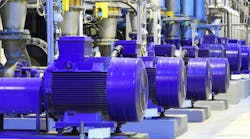Motor change-outs often occur under intense pressure, and the temptation to take shortcuts is strong. Doing the job as fast as possible, however, usually leads to more downtime, inefficient operation, and other problems. One of those other problems is injury due to unsafe acts. Injuries include back strain, shoulder strain, and pinched fingers. Working at a frantic pace also sets the stage for fall injuries due to slipping or tripping hazards.
Follow these tips to be safe:
- Work methodically and per procedure to improve safety and reduce mistakes.
- Have a designated place (e.g., a cart) for tools and test equipment not in use.
- Have a designated place for lubricants and new fasteners.
- Put removed fasteners directly into designated containers. This improves safety and keeps fasteners from getting lost.
- After removing the old motor, clean up the immediate area so you can safely and efficiently proceed with installing the new one. This doesn’t take long.
- Don't manhandle the motor into place. Use slings and bars, as appropriate.


